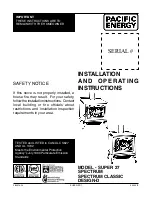
09-20020-306
Pos-
ition
Description
Primary air open (when lighting the stove)
Secondary air open (afterburning)
Glass rinse open
Secondary air open (afterburning)
Glass rinse open
Minimum secondary air inlet open (after-
burning)
Advice
Never burn wood with an open door.
Stoke the appliance regularly and thoroughly.
If you frequently burn at a low setting, tar and
creosote may be deposited in the flue. Tar and
creosote are highly combustible substances.
Thicker layers of these substances may catch
fire if the temperature in the flue increases sud-
denly. By burning the fire at a high intensity on
a regular basis, any layers of tar and creosote
will disappear.
Burning at a low intensity can also cause tar to
be deposited on the appliance window and
door.
When the outside temperature is mild, it is bet-
ter to burn wood intensely for a few hours
instead of having a low intensity fire for a long
period of time.
Control the air supply using the air vent.
The air inlet not only supplies air to the fire but
to the glass as well, so that it does not quickly
become dirty.
Open the primary air inlet for the time being if the air
supply by the secondary air inlet is inadequate or if
you want to fan the fire.
Topping up with a few logs regularly is better than
adding many logs in one go.
Extinguishing the fire
Do not add fuel and just let the fire go out. If a fire is
damped down by reducing the air supply, harmful sub-
stances will be released. For this reason, the fire
should be allowed to go out naturally. Keep an eye on
the fire until it has gone out. All air inlets can be closed
once the fire has died completely.
Removing ash
After wood has been burnt, a relatively small amount
of ash remains. This ash bed is a good insulating layer
for the stove base plate and improves combustion. It
is a good idea to leave a thin layer of ash on the stove
base plate.
The flow of air through the stove base plate must not
be obstructed. Remove the excess ash regularly.
1. Open the door of the appliance.
2. Scoop the excess ash from the appliance or use a
special ash vacuum cleaner to remove the excess
ash.
Always use an ash vacuum cleaner; using an
ordinary vacuum cleaner that has not been spe-
cially modified can cause serious damage to
an ordinary vacuum cleaner.
3. Close the door of the appliance.
Fog and mist
Fog and mist hinder the flow of flue gases through the
flue. Smoke can blow back and cause a stench. If it is
not strictly necessary, it is better not to use the stove
in foggy and misty weather.
Resolving problems
Refer to the appendix "Diagnostic diagram" to resolve
any problems in using the appliance.
Subject to change because of technical improvements
15
Summary of Contents for ZEN 100
Page 27: ......
Page 28: ...E O E...














































